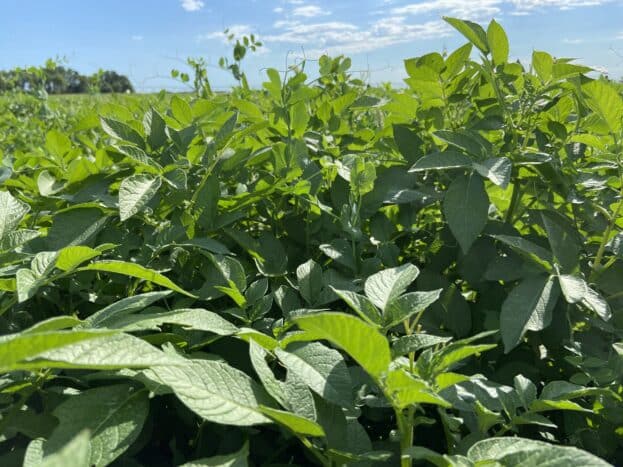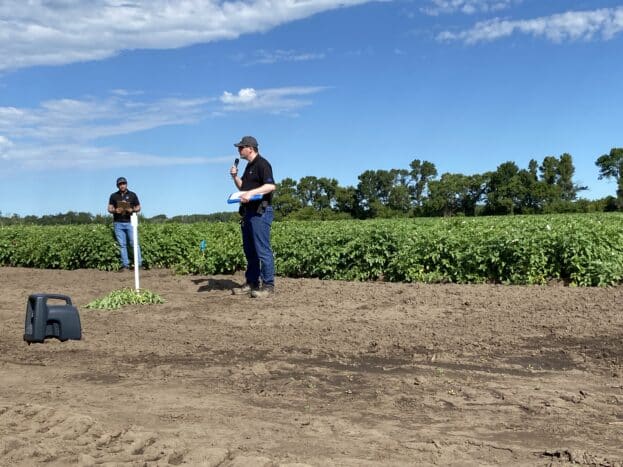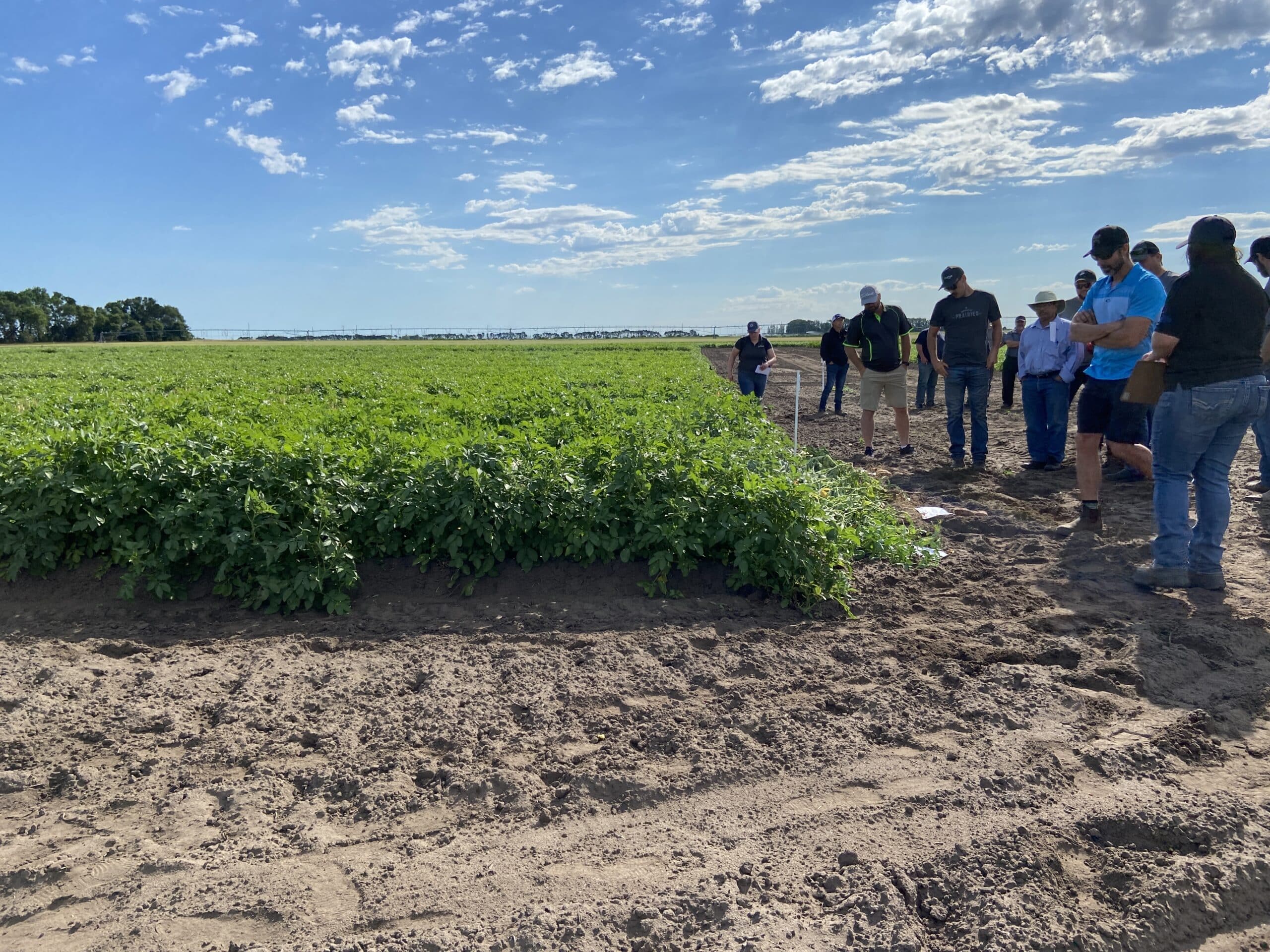Soil health and disease management research highlighted at CMCDC Field Day on Aug. 9, 2022.
Soil health and disease management are always topics that potato growers are interested in learning more about.
At the Canada-Manitoba Crop Diversification Centre (CMCDC) Field Day in Carberry, Man. on Aug. 9 the latest research projects the CMCDC and MHPEC Inc. teams are focusing on were featured. While the teams are working on a number of projects, three of the highlighted included a nitrogen leaching study, cover cropping and non-chemical black dot management.
Reducing Nitrogen Applications in Potato Fields
When it comes to applying nitrogen to potato crops, timing is paramount, Haider Abbas, applied research specialist at CMCDC, explains during the field day.
“If we apply too much nitrogen at once, and we apply irrigation at the same time, there is a potential of seeing some nitrogen within the root zone. But a majority of nitrogen leach down from the potato active root zone and that becomes contamination to groundwater,” he adds.
From the team at CMCDC’s study, they’ve discovered potatoes need more soil nitrogen than is usually available during the row closure stage. Abbas explains that preseason fertilizer choices, soil type and irrigation or how rainfall amounts work together can affect the amount of soil nitrogen available. He adds using urea on lighter-textured irrigated soils can cause nitrogen deficiency by row closure. This has also been noticed in pre-plant broadcast applications of environmentally smart nitrogen (ESN), that can delay the release of nitrogen until enough moisture and heat is available.
To test for nitrogen contamination of groundwater, the CMCDC team tests nitrogen concentration at .2, .4., .6, .8 and one metre levels. For potatoes, .6 metres is the active root zoon while one metre is the full root zoon, Abbas says. If the groundwater comes above 2.5 metres deep, it can potentially lead to nitrogen leaching.
“There’s a potential of during dry days that this groundwater becomes available to potato plants and it’s through upward rise or capillary rise it becomes available to plants to fulfill some irrigation deficiency,” he explains. “So, you’re applying even more nitrate polluting water to your plants. You already applied some nitrogen that’s excessive from the top and then coming more from the bottom.”
With this study the CMCDC team wants to show how important it’s to test groundwater during the growing season to make sure growers aren’t overapplying nitrogen to potato crops.
Building Soil Health in Potato Crops
Soil health is becoming more and more paramount in the potato industry, which has more growers looking for ways to build their soil health. The CMCDC team are testing out cover cropping systems at their site to help build soil health.
Andrea Hamilton, the applied research technician for MHPEC Inc. explains they’re looking at cropping options for the spring and fall “shoulder” growing seasons. They planted a spring wheat as it’s a quick emerging cereal crop, and then as a companion crop peas were planted to help supply nutrients organically. The seed was broadcast in the front of the potato planter and then worked into the soil with the planting pass.

“The jury’s still out whether it actually helped within season, but it’ll definitely help that organic nitrogen and throughout the rotation. Whenever you incorporate a legume within the system, it’s a positive outcome,” she says during the field day.
With the cover crops, Hamilton explains they’re looking to incorporate every broad species combination — grasses, legumes, and a broadleaf. They’re still working on deciding which crops to plant for the fall, but they’re looking at these three options and may also plant a biannual option where it would come back in the spring, to help with spring cover soil coverage.
Ridding Potato Fields of Black Dot
When Zack Frederick, the applied potato research agronomist for MHPEC Inc. was completing his doctoral studies at the Washington State University under Dennis Johnson, one of the projects he was involved with was looking into if extending crop rotations could rid fields of black dot.
“If you increase the rotation of on potatoes in terms of number of years, potentially from six to eight years, (Johnson) thought the need for chemical control could be reduced or potentially eliminated,” Frederick explains at the field day. Adding there should be less disease pressure from black dot noticed in the field.
While extending a crop rotation to eight years generally isn’t feasible, Frederick did see opportunity to experiment with vine control in fields. For black dot to build up in the soil it must have the vines return to the soil to refresh itself. If the vines aren’t there for this to happen, then the black dot presence should be much weaker in another three years.

“If we can fake a longer rotation by preventing the return of the fresh stuff, the old stuff will be getting progressively older and weaker as time goes on. And we might be able to achieve something more like that eight-year rotation by just preventing new inoculum from returning to the soil,” Frederick explains.
To do this, the CMCDC team are physically removing the vines by hand from the plot at Carberry which black dot in it. The theory is that this will also work for other fungal pathogens such as early blight and verticillium that need the vine to get back into the soil.
“Harvest is usually quite busy and often quite shortened and time if we have foul weather, for example. So, adding more to the work list and harvest is a deeply unpopular subject,” Frederick says. “Once we have an idea of whether it works, I will probably get more traction from the community on how to actually remove the vines from the field.”
Header photo — A group checks out the cover cropping plot at CMCDC’s field site at Carberry, Man. during a field day on Aug. 9, 2022. Photo: Ashley Robinson
Related Articles
Latest Manitoba Potato Research Showcased at Field Day
Exterminating Verticillium wilt from Potato Fields with Mustard Biofumigation









